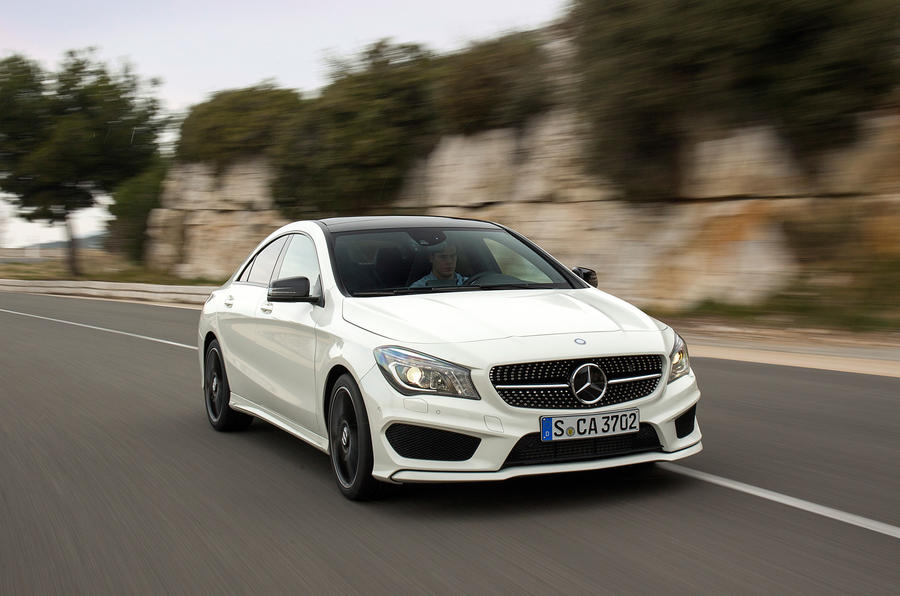What is it?
The rebuilding of Mercedes-Benz’s small car ranks began with the latest Mercedes-Benz B-Class MPV, gaining momentum with the new Mercedes-Benz A-Class hatchback. Now it is moving into top gear with this, the CLA – a car that many expect to revive the compact saloon car market, and with it Mercedes’ ability to attract a younger generation of buyers.
Appearing like a scaled-down Mercedes-Benz CLS, it brings a welcome dose of style to a class long renowned for prosaic looks.
The front is mostly shared with the latest A-class, upon which the CLA is largely based. It’s at the rear where the new saloon differs from its hatchback sibling, with a heavily curved roofline, curvaceous pillars, angled rear screen, sloping bootlid and longer overhang. The CLA also uses frameless doors in a bid to give it coupé-like appeal.
It’s not just good looking but also aerodynamically efficient. Mercedes claims a Cd of 0.23 for regular models.
The CLA is 40mm longer, 7mm wider and 43mm lower than the C-class – itself set to grow appreciably when the new version appears next year. It’s not the end of Mercedes’ efforts to rebuild its small car ranks, though. An even more radical-looking CLA Shooting Brake is due to reach the UK in just over a year’s time.
What's it like?
Climb inside and you discover an interior that shares its entire layout, including the dashboard, switchgear and trims, with the A-class. Good aspects include the driving position, supportive front seats, legible instruments, the feel of the leather-bound steering wheel, the easily read high-mounted infotainment monitor and overall quality of the materials.
Where the CLA falls down is in its failure to provide adequate rearward vision. A combination of factors – such as wide pillars, a high waistline, tall front seatbacks and a shallow rear screen – contrives to rob visibility to the sides and back. It’s bad enough to consider the optional Tracking Package, which brings blindspot and lane-keeping functions, as a must-have item.
Despite being marginally longer than the C-class saloon, the CLA lacks genuine rear seat space, and entry to the rear is made tricky by the heavy tumblehome effect to the shallow side glass. However, it has a generous-sized boot with a 470-litre capacity – 11 litres more than the C-class’s.
In the UK, two turbocharged four-cylinder engines will initially be offered in the CLA. The base CLA 180 gets a 1.6-litre petrol unit developed in partnership with Renault that produces a less than sparkling 120bhp. It is joined by a 2.1-litre diesel that develops 168bhp in the CLA 220 CDI driven here. We’ll also get a 2.0-litre petrol engine with 208bhp in the CLA 250 later this year.
Most engines come with the choice of a six-speed manual or seven-speed dual-clutch automatic, but the CLA 220 CDI is auto only. It is an efficient unit, with a column-mounted stalk taking the place of a traditional gear selector and wheel-mounted shift paddles that make cog swapping a painless if somewhat uninspiring affair.
But with 258lb ft from 1400 to 3400rpm, the CLA 220 CDI doesn’t require continual gearshifting. Its willing, flexible delivery makes for easy progress. However, go above 4000rpm and there’s a noticeable degree of diesel chatter.

























Join the debate
Add your comment
I seem to recall that most of
I seem to recall that most of the C-Class reviews criticised the Sport version for poor ride quality - I was astounded when I tried one as my local roads are heavily potholed yet the ride was perfectly good. Not limo levels of glide, but perfectly comfortable.
My suspicion is that the new A-class and CLA have a similarly acceptable ride.
Oh Dear ...
Looks like Mercedes-Benz's design team went to the same school of "how to mash two cars designs together and make a pig's ear" as BMW ...
I wouldn't say a change in
I wouldn't say a change in the brand's strategy, the original A-Class was launched 17 years ago!